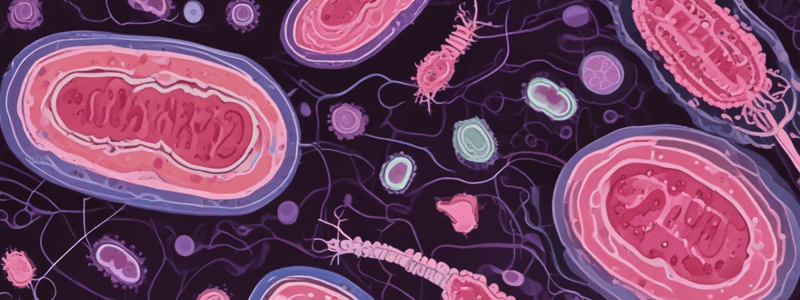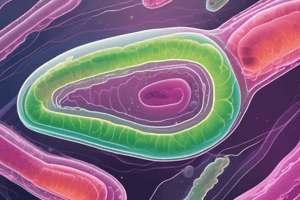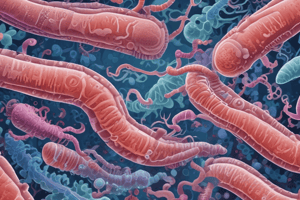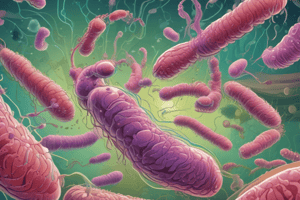Podcast
Questions and Answers
What is the mechanism used by EPEC to attach to intestinal epithelial cells?
What is the mechanism used by EPEC to attach to intestinal epithelial cells?
Bundle-forming pili (BFP)
What is the outcome of EPEC's injection of effector proteins into intestinal epithelial cells?
What is the outcome of EPEC's injection of effector proteins into intestinal epithelial cells?
Pedestal formation and microvilli effacement, impairing absorption
What type of fimbriae does UPEC use to adhere to uroepithelial cells?
What type of fimbriae does UPEC use to adhere to uroepithelial cells?
Type 1 fimbriae and P fimbriae
What is the result of UPEC's toxin production in the urinary tract?
What is the result of UPEC's toxin production in the urinary tract?
What is the more severe complication that can arise from UPEC's ascending infection?
What is the more severe complication that can arise from UPEC's ascending infection?
What is the mechanism of intestinal injury caused by Shiga-like toxin-producing E. coli (STEC)?
What is the mechanism of intestinal injury caused by Shiga-like toxin-producing E. coli (STEC)?
What is the outcome of Enterotoxigenic E. coli (ETEC) infection?
What is the outcome of Enterotoxigenic E. coli (ETEC) infection?
How does Enteroinvasive E. coli (EIEC) cause disease?
How does Enteroinvasive E. coli (EIEC) cause disease?
What is the effect of Shiga-like toxins on the kidneys in Hemolytic Uremic Syndrome (HUS)?
What is the effect of Shiga-like toxins on the kidneys in Hemolytic Uremic Syndrome (HUS)?
What is the result of platelet activation in Hemolytic Uremic Syndrome (HUS)?
What is the result of platelet activation in Hemolytic Uremic Syndrome (HUS)?
How do Shiga-like toxins cause hemolytic anemia in Hemolytic Uremic Syndrome (HUS)?
How do Shiga-like toxins cause hemolytic anemia in Hemolytic Uremic Syndrome (HUS)?
What is the effect of clot formation in the arterioles in Hemolytic Uremic Syndrome (HUS)?
What is the effect of clot formation in the arterioles in Hemolytic Uremic Syndrome (HUS)?
What is the mechanism of action of heat-labile enterotoxin (LT) in Enterotoxigenic E. coli (ETEC)?
What is the mechanism of action of heat-labile enterotoxin (LT) in Enterotoxigenic E. coli (ETEC)?
What is the primary age group affected by EPEC?
What is the primary age group affected by EPEC?
What is the result of UPEC's colonization of the periurethral area?
What is the result of UPEC's colonization of the periurethral area?
What is the role of type 1 fimbriae in UPEC infection?
What is the role of type 1 fimbriae in UPEC infection?
What is the effect of EPEC's injection of effector proteins?
What is the effect of EPEC's injection of effector proteins?
What is the complication that can arise from UPEC's ascending infection?
What is the complication that can arise from UPEC's ascending infection?
What is the primary mechanism of intestinal injury caused by Shiga-like toxin-producing E. coli (STEC)?
What is the primary mechanism of intestinal injury caused by Shiga-like toxin-producing E. coli (STEC)?
Which of the following is a characteristic of Enterotoxigenic E. coli (ETEC) infection?
Which of the following is a characteristic of Enterotoxigenic E. coli (ETEC) infection?
What is the result of Shiga-like toxin binding to endothelial cells in the glomeruli during Hemolytic Uremic Syndrome (HUS)?
What is the result of Shiga-like toxin binding to endothelial cells in the glomeruli during Hemolytic Uremic Syndrome (HUS)?
What is the primary mechanism of disease caused by Enteroinvasive E. coli (EIEC)?
What is the primary mechanism of disease caused by Enteroinvasive E. coli (EIEC)?
What is the result of clot formation in the arterioles during Hemolytic Uremic Syndrome (HUS)?
What is the result of clot formation in the arterioles during Hemolytic Uremic Syndrome (HUS)?
What is the primary mechanism of intestinal attachment used by Shiga-like toxin-producing E. coli (STEC)?
What is the primary mechanism of intestinal attachment used by Shiga-like toxin-producing E. coli (STEC)?
What is the result of thrombocytopenia in Hemolytic Uremic Syndrome (HUS)?
What is the result of thrombocytopenia in Hemolytic Uremic Syndrome (HUS)?
What is the primary mechanism of disease caused by Enterotoxigenic E. coli (ETEC)?
What is the primary mechanism of disease caused by Enterotoxigenic E. coli (ETEC)?
Match the following E. coli strains with their primary site of infection:
Match the following E. coli strains with their primary site of infection:
Match the following E. coli strains with their primary mode of attachment:
Match the following E. coli strains with their primary mode of attachment:
Match the following E. coli strains with their primary toxin production:
Match the following E. coli strains with their primary toxin production:
Match the following E. coli strains with their primary disease manifestations:
Match the following E. coli strains with their primary disease manifestations:
Match the following E. coli strains with their primary age group affected:
Match the following E. coli strains with their primary age group affected:
Match the following E. coli pathotypes with their primary mechanism of intestinal attachment:
Match the following E. coli pathotypes with their primary mechanism of intestinal attachment:
Match the following E. coli pathotypes with their primary toxin:
Match the following E. coli pathotypes with their primary toxin:
Match the following E. coli pathotypes with their primary clinical outcome:
Match the following E. coli pathotypes with their primary clinical outcome:
Match the following E. coli pathotypes with their primary mechanism of intestinal injury:
Match the following E. coli pathotypes with their primary mechanism of intestinal injury:
Match the following E. coli pathotypes with their primary target cells:
Match the following E. coli pathotypes with their primary target cells:
Match the following E. coli pathotypes with their primary disease outcome:
Match the following E. coli pathotypes with their primary disease outcome:
Match the following E. coli pathotypes with their primary mode of transmission:
Match the following E. coli pathotypes with their primary mode of transmission:
Match the following E. coli pathotypes with their primary complications:
Match the following E. coli pathotypes with their primary complications:
EPEC uses ______ to attach to intestinal epithelial cells.
EPEC uses ______ to attach to intestinal epithelial cells.
UPEC uses ______ to adhere to uroepithelial cells.
UPEC uses ______ to adhere to uroepithelial cells.
Shiga-like toxin-producing E. coli (STEC) attaches to the host's intestinal cells using ______.
Shiga-like toxin-producing E. coli (STEC) attaches to the host's intestinal cells using ______.
EPEC injects ______ proteins via a Type III secretion system.
EPEC injects ______ proteins via a Type III secretion system.
Shiga-like toxins (Stx1 and Stx2) cause damage to the intestinal ______ and blood vessels.
Shiga-like toxins (Stx1 and Stx2) cause damage to the intestinal ______ and blood vessels.
The toxins enter the bloodstream, affecting the ______.
The toxins enter the bloodstream, affecting the ______.
UPEC produces ______ hemolysins, causing lysis of urinary tract cells.
UPEC produces ______ hemolysins, causing lysis of urinary tract cells.
EPEC primarily affects children under ______ years of age.
EPEC primarily affects children under ______ years of age.
Toxins bind to endothelial cells in the ______, causing apoptosis and gaps in the capillary walls.
Toxins bind to endothelial cells in the ______, causing apoptosis and gaps in the capillary walls.
Enterotoxigenic E. coli (ETEC) uses ______ to adhere to the intestinal mucosa.
Enterotoxigenic E. coli (ETEC) uses ______ to adhere to the intestinal mucosa.
Heat-labile enterotoxin (LT) activates ______, increasing cAMP, leading to chloride and water secretion.
Heat-labile enterotoxin (LT) activates ______, increasing cAMP, leading to chloride and water secretion.
Enteroinvasive E. coli (EIEC) attaches to and invades ______ epithelial cells.
Enteroinvasive E. coli (EIEC) attaches to and invades ______ epithelial cells.
In Hemolytic Uremic Syndrome (HUS), clots obstruct ______, leading to kidney ischemia, reduced filtration, and uremia.
In Hemolytic Uremic Syndrome (HUS), clots obstruct ______, leading to kidney ischemia, reduced filtration, and uremia.
Shiga-like toxin-producing E. coli (STEC) causes bloody diarrhea.
Shiga-like toxin-producing E. coli (STEC) causes bloody diarrhea.
Enterotoxigenic E. coli (ETEC) causes a strong inflammatory response.
Enterotoxigenic E. coli (ETEC) causes a strong inflammatory response.
Enteroinvasive E. coli (EIEC) attaches to and invades intestinal epithelial cells.
Enteroinvasive E. coli (EIEC) attaches to and invades intestinal epithelial cells.
Hemolytic Uremic Syndrome (HUS) is a complication of ETEC infection.
Hemolytic Uremic Syndrome (HUS) is a complication of ETEC infection.
Shiga-like toxins cause apoptosis in endothelial cells in the glomeruli.
Shiga-like toxins cause apoptosis in endothelial cells in the glomeruli.
Enterotoxigenic E. coli (ETEC) produces heat-stable enterotoxin (ST).
Enterotoxigenic E. coli (ETEC) produces heat-stable enterotoxin (ST).
Shiga-like toxin-producing E. coli (STEC) causes hemolytic anemia.
Shiga-like toxin-producing E. coli (STEC) causes hemolytic anemia.
Enteroinvasive E. coli (EIEC) produces Shiga-like toxins.
Enteroinvasive E. coli (EIEC) produces Shiga-like toxins.
EPEC causes pedestal formation and microvilli effacement through its type 1 fimbriae.
EPEC causes pedestal formation and microvilli effacement through its type 1 fimbriae.
UPEC produces alpha and beta hemolysins, causing lysis of urinary tract cells and leading to pyelonephritis.
UPEC produces alpha and beta hemolysins, causing lysis of urinary tract cells and leading to pyelonephritis.
EPEC primarily affects adults above 50 years of age.
EPEC primarily affects adults above 50 years of age.
UPEC can colonize the periurethral area and descend the urinary tract.
UPEC can colonize the periurethral area and descend the urinary tract.
EPEC injects effector proteins via a Type II secretion system, causing actin cytoskeleton rearrangement.
EPEC injects effector proteins via a Type II secretion system, causing actin cytoskeleton rearrangement.
Flashcards are hidden until you start studying
Study Notes
Shiga-like Toxin-Producing E.coli (STEC)
- Attaches to host's intestinal cells using fimbriae
- Produces Shiga-like toxins (Stx1 and Stx2) which cause damage to intestinal epithelium and blood vessels
- Intestinal injury leads to inflammation, fluid and blood leakage into the intestinal lumen, resulting in bloody diarrhea
- Toxins can enter the bloodstream, causing Hemolytic Uremic Syndrome (HUS)
Hemolytic Uremic Syndrome (HUS)
- Toxins bind to endothelial cells in the glomeruli, causing apoptosis and gaps in the capillary walls, leading to proteinuria
- Inflammatory response leads to platelet activation, clot formation, and thrombocytopenia
- Red blood cells are fragmented as they pass through obstructed microvessels, resulting in hemolytic anemia
- Clots obstruct arterioles, leading to kidney ischemia, reduced filtration, and uremia
Enterotoxigenic E.coli (ETEC)
- Attaches to intestinal mucosa using fimbriae
- Produces heat-labile enterotoxin (LT) and heat-stable enterotoxin (ST)
- LT activates adenylate cyclase, increasing cAMP, leading to chloride and water secretion
- ST activates guanylate cyclase, increasing cGMP, leading to electrolyte and water secretion
- Causes watery diarrhea without damaging the intestinal wall
Enteroinvasive E.coli (EIEC)
- Attaches to and invades intestinal epithelial cells
- Invades and multiplies within epithelial cells, causing cell destruction and widespread epithelial damage
- Triggers a strong inflammatory response, leading to bloody diarrhea
Enteropathogenic E.coli (EPEC)
- Attaches to intestinal epithelial cells using bundle-forming pili (BFP)
- Injects effector proteins via a Type III secretion system, causing actin cytoskeleton rearrangement and pedestal formation
- Leads to microvilli effacement, impairing absorption and causing watery diarrhea, primarily in children under two years of age
Uropathogenic E.coli (UPEC)
- Colonizes the periurethral area and ascends the urinary tract
- Adheres to uroepithelial cells using type 1 fimbriae and P fimbriae
- Invades and replicates within bladder cells, causing lysis of urinary tract cells
- Can cause cystitis, characterized by dysuria and frequent urination, and pyelonephritis, characterized by flank pain and more severe symptoms
Shiga-like Toxin-Producing E.coli (STEC)
- Attaches to host's intestinal cells using fimbriae
- Produces Shiga-like toxins (Stx1 and Stx2) which cause damage to intestinal epithelium and blood vessels
- Intestinal injury leads to inflammation, fluid and blood leakage into the intestinal lumen, resulting in bloody diarrhea
- Toxins can enter the bloodstream, causing Hemolytic Uremic Syndrome (HUS)
Hemolytic Uremic Syndrome (HUS)
- Toxins bind to endothelial cells in the glomeruli, causing apoptosis and gaps in the capillary walls, leading to proteinuria
- Inflammatory response leads to platelet activation, clot formation, and thrombocytopenia
- Red blood cells are fragmented as they pass through obstructed microvessels, resulting in hemolytic anemia
- Clots obstruct arterioles, leading to kidney ischemia, reduced filtration, and uremia
Enterotoxigenic E.coli (ETEC)
- Attaches to intestinal mucosa using fimbriae
- Produces heat-labile enterotoxin (LT) and heat-stable enterotoxin (ST)
- LT activates adenylate cyclase, increasing cAMP, leading to chloride and water secretion
- ST activates guanylate cyclase, increasing cGMP, leading to electrolyte and water secretion
- Causes watery diarrhea without damaging the intestinal wall
Enteroinvasive E.coli (EIEC)
- Attaches to and invades intestinal epithelial cells
- Invades and multiplies within epithelial cells, causing cell destruction and widespread epithelial damage
- Triggers a strong inflammatory response, leading to bloody diarrhea
Enteropathogenic E.coli (EPEC)
- Attaches to intestinal epithelial cells using bundle-forming pili (BFP)
- Injects effector proteins via a Type III secretion system, causing actin cytoskeleton rearrangement and pedestal formation
- Leads to microvilli effacement, impairing absorption and causing watery diarrhea, primarily in children under two years of age
Uropathogenic E.coli (UPEC)
- Colonizes the periurethral area and ascends the urinary tract
- Adheres to uroepithelial cells using type 1 fimbriae and P fimbriae
- Invades and replicates within bladder cells, causing lysis of urinary tract cells
- Can cause cystitis, characterized by dysuria and frequent urination, and pyelonephritis, characterized by flank pain and more severe symptoms
Shiga-like Toxin-Producing E.coli (STEC)
- Attaches to host's intestinal cells using fimbriae
- Produces Shiga-like toxins (Stx1 and Stx2) which cause damage to intestinal epithelium and blood vessels
- Intestinal injury leads to inflammation, fluid and blood leakage into the intestinal lumen, resulting in bloody diarrhea
- Toxins can enter the bloodstream, causing Hemolytic Uremic Syndrome (HUS)
Hemolytic Uremic Syndrome (HUS)
- Toxins bind to endothelial cells in the glomeruli, causing apoptosis and gaps in the capillary walls, leading to proteinuria
- Inflammatory response leads to platelet activation, clot formation, and thrombocytopenia
- Red blood cells are fragmented as they pass through obstructed microvessels, resulting in hemolytic anemia
- Clots obstruct arterioles, leading to kidney ischemia, reduced filtration, and uremia
Enterotoxigenic E.coli (ETEC)
- Attaches to intestinal mucosa using fimbriae
- Produces heat-labile enterotoxin (LT) and heat-stable enterotoxin (ST)
- LT activates adenylate cyclase, increasing cAMP, leading to chloride and water secretion
- ST activates guanylate cyclase, increasing cGMP, leading to electrolyte and water secretion
- Causes watery diarrhea without damaging the intestinal wall
Enteroinvasive E.coli (EIEC)
- Attaches to and invades intestinal epithelial cells
- Invades and multiplies within epithelial cells, causing cell destruction and widespread epithelial damage
- Triggers a strong inflammatory response, leading to bloody diarrhea
Enteropathogenic E.coli (EPEC)
- Attaches to intestinal epithelial cells using bundle-forming pili (BFP)
- Injects effector proteins via a Type III secretion system, causing actin cytoskeleton rearrangement and pedestal formation
- Leads to microvilli effacement, impairing absorption and causing watery diarrhea, primarily in children under two years of age
Uropathogenic E.coli (UPEC)
- Colonizes the periurethral area and ascends the urinary tract
- Adheres to uroepithelial cells using type 1 fimbriae and P fimbriae
- Invades and replicates within bladder cells, causing lysis of urinary tract cells
- Can cause cystitis, characterized by dysuria and frequent urination, and pyelonephritis, characterized by flank pain and more severe symptoms
Shiga-like Toxin-Producing E.coli (STEC)
- Attaches to host's intestinal cells using fimbriae
- Produces Shiga-like toxins (Stx1 and Stx2) which cause damage to intestinal epithelium and blood vessels
- Intestinal injury leads to inflammation, fluid and blood leakage into the intestinal lumen, resulting in bloody diarrhea
- Toxins can enter the bloodstream, causing Hemolytic Uremic Syndrome (HUS)
Hemolytic Uremic Syndrome (HUS)
- Toxins bind to endothelial cells in the glomeruli, causing apoptosis and gaps in the capillary walls, leading to proteinuria
- Inflammatory response leads to platelet activation, clot formation, and thrombocytopenia
- Red blood cells are fragmented as they pass through obstructed microvessels, resulting in hemolytic anemia
- Clots obstruct arterioles, leading to kidney ischemia, reduced filtration, and uremia
Enterotoxigenic E.coli (ETEC)
- Attaches to intestinal mucosa using fimbriae
- Produces heat-labile enterotoxin (LT) and heat-stable enterotoxin (ST)
- LT activates adenylate cyclase, increasing cAMP, leading to chloride and water secretion
- ST activates guanylate cyclase, increasing cGMP, leading to electrolyte and water secretion
- Causes watery diarrhea without damaging the intestinal wall
Enteroinvasive E.coli (EIEC)
- Attaches to and invades intestinal epithelial cells
- Invades and multiplies within epithelial cells, causing cell destruction and widespread epithelial damage
- Triggers a strong inflammatory response, leading to bloody diarrhea
Enteropathogenic E.coli (EPEC)
- Attaches to intestinal epithelial cells using bundle-forming pili (BFP)
- Injects effector proteins via a Type III secretion system, causing actin cytoskeleton rearrangement and pedestal formation
- Leads to microvilli effacement, impairing absorption and causing watery diarrhea, primarily in children under two years of age
Uropathogenic E.coli (UPEC)
- Colonizes the periurethral area and ascends the urinary tract
- Adheres to uroepithelial cells using type 1 fimbriae and P fimbriae
- Invades and replicates within bladder cells, causing lysis of urinary tract cells
- Can cause cystitis, characterized by dysuria and frequent urination, and pyelonephritis, characterized by flank pain and more severe symptoms
Shiga-like Toxin-Producing E.coli (STEC)
- Attaches to host's intestinal cells using fimbriae
- Produces Shiga-like toxins (Stx1 and Stx2) which cause damage to intestinal epithelium and blood vessels
- Intestinal injury leads to inflammation, fluid and blood leakage into the intestinal lumen, resulting in bloody diarrhea
- Toxins can enter the bloodstream, causing Hemolytic Uremic Syndrome (HUS)
Hemolytic Uremic Syndrome (HUS)
- Toxins bind to endothelial cells in the glomeruli, causing apoptosis and gaps in the capillary walls, leading to proteinuria
- Inflammatory response leads to platelet activation, clot formation, and thrombocytopenia
- Red blood cells are fragmented as they pass through obstructed microvessels, resulting in hemolytic anemia
- Clots obstruct arterioles, leading to kidney ischemia, reduced filtration, and uremia
Enterotoxigenic E.coli (ETEC)
- Attaches to intestinal mucosa using fimbriae
- Produces heat-labile enterotoxin (LT) and heat-stable enterotoxin (ST)
- LT activates adenylate cyclase, increasing cAMP, leading to chloride and water secretion
- ST activates guanylate cyclase, increasing cGMP, leading to electrolyte and water secretion
- Causes watery diarrhea without damaging the intestinal wall
Enteroinvasive E.coli (EIEC)
- Attaches to and invades intestinal epithelial cells
- Invades and multiplies within epithelial cells, causing cell destruction and widespread epithelial damage
- Triggers a strong inflammatory response, leading to bloody diarrhea
Enteropathogenic E.coli (EPEC)
- Attaches to intestinal epithelial cells using bundle-forming pili (BFP)
- Injects effector proteins via a Type III secretion system, causing actin cytoskeleton rearrangement and pedestal formation
- Leads to microvilli effacement, impairing absorption and causing watery diarrhea, primarily in children under two years of age
Uropathogenic E.coli (UPEC)
- Colonizes the periurethral area and ascends the urinary tract
- Adheres to uroepithelial cells using type 1 fimbriae and P fimbriae
- Invades and replicates within bladder cells, causing lysis of urinary tract cells
- Can cause cystitis, characterized by dysuria and frequent urination, and pyelonephritis, characterized by flank pain and more severe symptoms
Studying That Suits You
Use AI to generate personalized quizzes and flashcards to suit your learning preferences.




